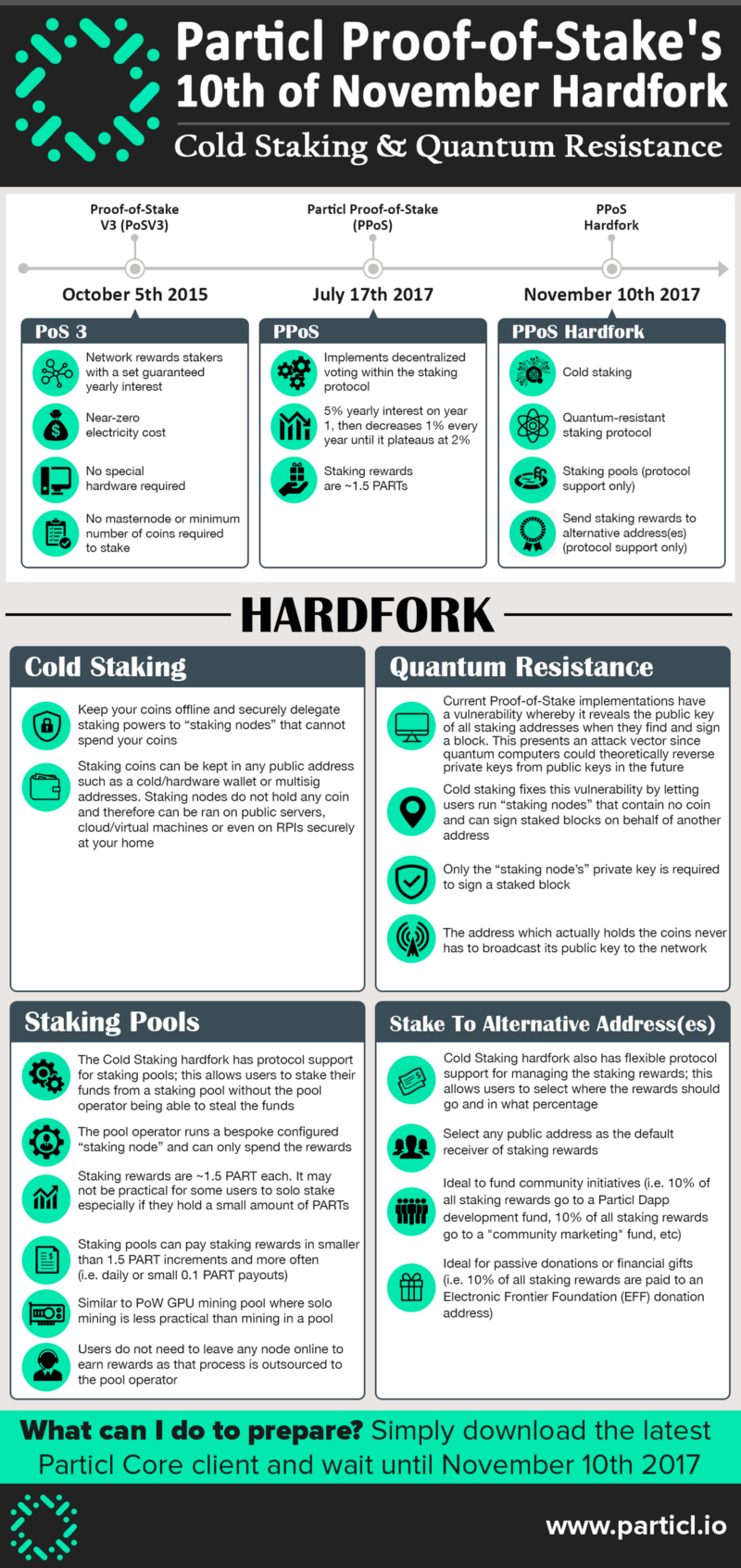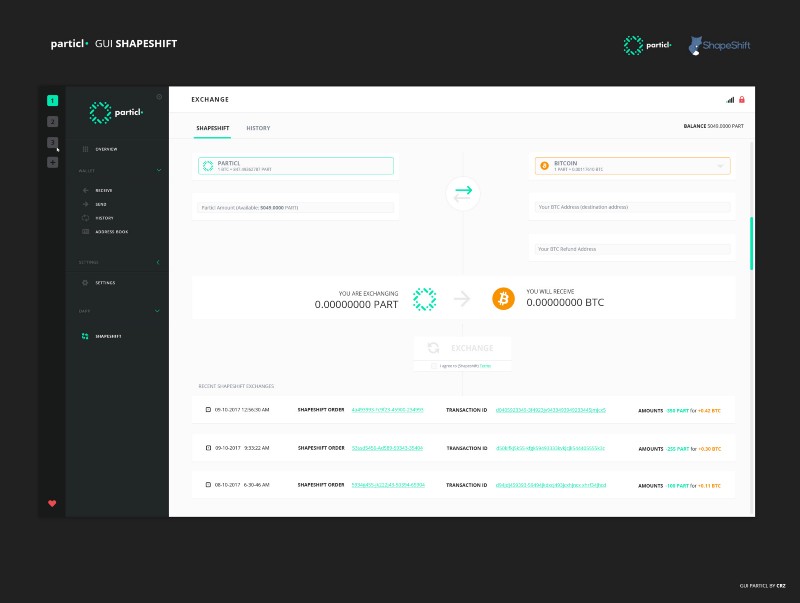Particl, a decentralized privacy platform and cryptocurrency, is just about to go through its first hardfork on the 10th of November 2017. Indeed, at 00:00 UTC, the Particl blockchain will hardfork to bring many critical changes to its Proof-of-Stake protocol, insuring that its foundation is as strong and secure as possible before the long-awaited Particl privacy marketplace is released. The two main changes to the protocol are the introduction of cold staking and a dramatic increase in quantum computer resistance. The hardfork also enables protocol support for staking pools and staking rewards management, meaning that while they will now be able to be implemented, they will not be present at the time of the fork.

Cold Staking
The main feature the hardfork will bring to Particl’s Proof-of-Stake protocol is the ability to securely delegate staking powers to “staking nodes”. The purpose of these “staking nodes” is to provide a dedicated resource connected to the Particl blockchain and stake on behalf of another wallet without being able to spend its coins.
The reason it is called “cold staking” is because this feature is intended to be used in combination with cold/hardware/paper wallets as well as multisig addresses, making it possible to stake “offline” coins with no risk of being hacked.
Staking nodes can be set up on public/cloud servers, virtual machines or even on RPIs. The staking environment theoretically doesn’t even need to be that much secure since these nodes do not contain or cannot be linked to any coin, meaning that you can pretty much stake from anywhere.
In the future, this feature is likely to become even more relevant when the Particl team will start developing the mobile wallet. This wallet is intended to have most or all of the desktop features, but actually staking from a mobile phone is far from being ideal. Not only would the network connection be unstable at times, it would also use a lot of data as you’d need to constantly download every blocks. With cold staking, you could simply stake your mobile funds from a RPI at home or any dedicated server and still get staking revenues from your mobile funds without busting the phone bill.
Quantum Resistance
Current Proof-of-Stake implementations have a vulnerability not present in Proof-of-Work whereby they reveal the public key of staking addresses when they find and sign blocks. The most dangerous attack by quantum computers is against public key cryptography. On traditional computers, it takes on the order of 2128 basic operations to get Bitcoin private keys associated with Bitcoin public keys. This number is so massively large that any attack using traditional computers is completely impractical. However, it is known for sure that it would take a sufficiently large quantum computer on the order of only 1283 basic quantum operations to be able to break a Bitcoin key using Shor’s algorithm. This might take some time, especially since the first quantum computers are likely to be extremely slow, but it is still very practical. It could be estimated that it is maybe 2 to 5 years until quantum computers become an issue, but any project that plans on staying relevant on a long period of time should tackle these vulnerabilities way before they become problematic.
It is worth mentioning that public keys are NOT public addresses. To reverse a private key from a public address, it would require more energy than what is available in the universe, therefore a quantum hacker cannot just go pick public addresses with large amounts and reverse those.
When a Particl block is created, the private key of the address that staked it is used to sign the block, effectively broadcasting its public key to the entire network. After the hardfork, “staking nodes” that do not contain any coin will be able to sign staked blocks on behalf of any wallet, hot or cold. Even if a quantum hacker successfully did reverse the staking node’s private key from its public key, he would not find any coin to steal.
Staking Pools (Protocol Support Only)
One very practical use case this hardfork enables is that it enables protocol support for staking pools. It means this feature will not be available at the time of the fork, but is rendered possible to code due to the changes brought by the hardfork.
It may not be immediately obvious why staking pools would be useful when you can securely stake from anywhere, but there are a couple of reasons some users may be drawn towards using them. First of all, staking a low Particl balance may not always be ideal. Since each staking reward is around 1.5 PART and the minimum yearly interest is 5%, there could be a lot of time in between staking rewards. For example, if someone wanted to buy $500 worth of Particl priced at 25$, he would end up with 20 PARTs. At 5% inflation rate, that person would earn around 1 Particl a year, which is even less than a single staking reward.
Similarly to PoW mining where solo mining Bitcoin with a single GPU card is now completely impractical, users with small Particl balances could simply delegate staking powers to pools and have them stake their coins on their behalf. As mentioned above, this will not be coded at the time of the fork, but it would be possible to configure staking nodes to be able to spend staking rewards only (no access to the actual staking funds whatsoever).
A pool operator could simply broadcast its staking node’s public key and have users “connect” and stake from it. Since these nodes could spend the rewards but not the staking funds, the pool operators could simply aggregate staking rewards into their own wallets and make custom payouts (i.e. daily or small 0.05 PART payouts).
Another use-case for staking pools is that the entire process of setting up and maintaining a secure staking node is outsourced to the pool operator. Users would only need to “connect” to the staking pool and not have to worry about setting up their own server/RPI. This is ideal for the less technical users that may eventually end up using Particl.
The current problem with staking pools is the transaction fees. Since the goal is to send smaller than 1.5 PART payouts, there may be a point where sending very small payouts would cost too much in terms of transaction fee. This is an issue that could easily be solved with the Lightning Network. Payment channels could be opened between users and the pool wallets and could eventually achieve near-zero transaction costs.
Stake To Alternative Address(es) (Protocol Support Only)
A second powerful but underestimated feature the hardfork adds protocol support for is the ability to fully manage staking rewards. This allows users to select where the rewards should go and in what percentage. This function will not be coded at the time of the fork, but it will now be possible to do it.
By default, staking rewards are given to the same address that stake (find and sign) a block. With this “alternative address” feature enabled, users would be able to automatically have these staking rewards sent to any public addresses and in any percentage. This killer feature leverages the amazing power of the Particl Proof-of-Stake protocol and enables a brand new way to spend, invest and donate money in a completely passive way. Here are a couple of examples that I believe could really help the Particl project make a name for itself:
1) Passive donations to crypto influencers
This, in my opinion, is a very powerful grassroots marketing strategy. The idea is to have crypto public figures such as youtubers or crypto celebs get a Particl address and share it. Then any Particl staker can choose the influencer’s address as a receiver of X% of his staking rewards. If enough stakers participate, the aggregated effect could make these passive donations quite large. If a crypto youtuber received 500$ worth of Particl everyday for some time, he’s for sure going to look in to the project at one point and the other and then maybe start talking about it.
2) Passive funding of community initiatives
Another brilliant way to use this potential feature is by creating community funds and bounties. If a community member has an idea for a Particl Dapp, widget, integration or marketing idea he could simply set up a public address and have X% of his staking rewards sent to it. If his idea gains traction within the community, other stakers could also start funding the initiative’s address and eventually create a sizable bounty to attract contributors. Combined with Particl’s decentralized voting, it is an entire decentralized ecosystem that enables the users to make things happen and get ideas funded without the need of any middleman.
3) Passive donations to organizations
This use-case is a bit more philanthropic, but practical nonetheless. Passive donations could be set up to any organization or charity that sets up a Particl public address. These organizations could be, for example, ones that seeks to fight for privacy and security like the TOR organization or the EFF. Not only would this help them accomplish their goals, but it would also be a good marketing strategy as many of these organizations display/showcase their big donors.
4) Budgeting & Diversification
Many addresses could be set up with different purposes and be passively funded using Particl’s Proof-of-Stake protocol. This would make it easier for stakers to save or invest money and would be an ideal budgeting strategy. For example, a user could set up a “Vacations Fund”, “Real Estate Downpayment Fund” or a “University Fund” and have any percentage of their daily staking rewards sent over there. Then, once they would reach their respective funding target, the funds they hold could be traded for fiat and then used to fulfil the goal they were initially created for. Alternatively, this same user could also set up a “Bitcoin Investment Fund” or “altcoin Investment Fund” where every week the PARTs they hold would be traded for BTCs or other altcoins using a GUI in-wallet token exchange application (such as Changelly, Shapeshift or flyp.me). This would make it easy for stakers to diversify their holdings into different coins while at the same time providing exchanges with more liquidity and volume

Particl currently has ~1.5 PART staking rewards and blocks of 2 minutes, meaning that roughly 1080 PARTs are created everyday. Priced at 7.50$, it is worth $8,100 and this daily source of funds will keep growing in value as Particl’s price increases. If enough stakers use this feature as a marketing strategy, the aggregated effect it could generate would definitely get people talking. You can only last so long not digging into a project that is funding you hundreds of dollars everyday!
The hardfork is scheduled for November 10th 2017, 00:00 UTC so make sure you upgrade your client to at least version 0.15.2 before that time. You do not need to move any wallet file, simply run the client from the updated folder! Since the Particl marketplace will also require a hardfork, it will be interesting to observe how the cold staking hardfork will unfold. At the time of this writing, 54% of the network has updated, so it seems things should go smoothly.